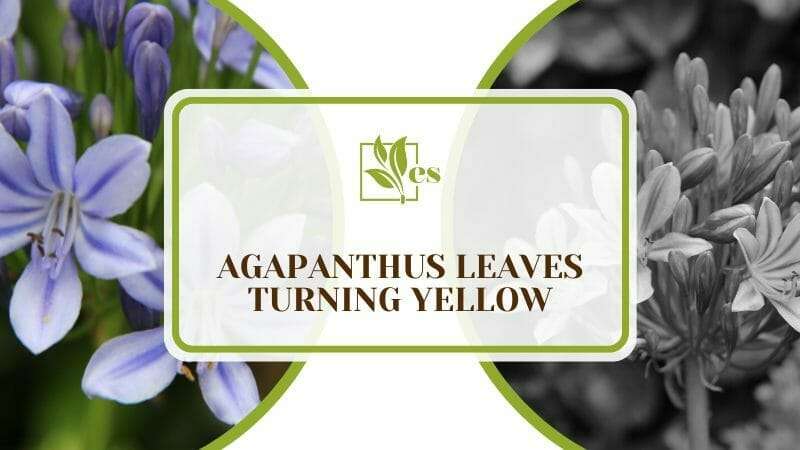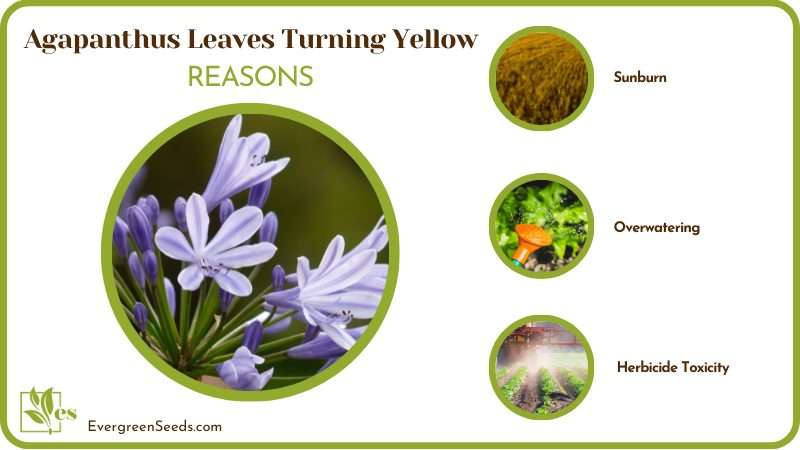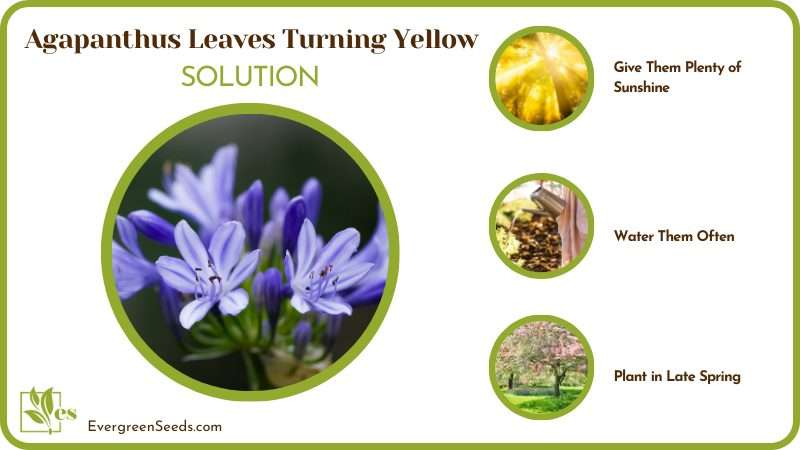Agapanthus leaves turning yellow should always get your attention because it is almost always a sign of trouble. Many people don’t know how to diagnose the problem of this Amaryllidaceae family plant in the first place.

Continue reading this expert article as we not only tell you how to identify the causes behind this yellowing but also how to solve them.
JUMP TO TOPIC
Why Are My Agapanthus Leaves Turning Yellow?
Agapanthus leaves might be turning yellow as a consequence of getting sunburnt, being overwatered, or when they are suffering from fungal diseases or pest attacks.
The long, curved and slender leaves of the Agapanthus genus plant turn yellow mostly when they are suffering from an external attack by fungi or pests. Lapses in care such as watering too much or putting them under very harsh sunlight will also produce chlorosis.
Read more about it in the upcoming sections.
– Sunburn
The Agapanthus plant needs at least five to six hours of sunlight each day to grow well. It is quite tolerant of sunlight as a whole. However, this plant can get sunburnt too when exposed to very high levels of sunlight.
The risk of getting a sunburn increases when the weather becomes hot and dry. The leaves turn yellow, crisp and dry. They droop down and in severe cases might even start falling off.
– Overwatering
Overwatering will definitely cause problems with Agapanthus plants. The lower leaves will be affected first, followed by the rest of the plant. These leaves will also be swollen and mushy due to water retention. Using tap water should not give you any issues as long as you purify it first.
This plant needs to be watered only when the top 3 inches of the soil become dry. Watering Agapanthus more than this may lead to overwatering. Overwatering also results from poor drainage. Your soil might be too compact or the drainage hole at the bottom of the pot is not large enough.

– Agapanthus Diseases
Leaf spot, root rot, and anthracnose are the most common fungal diseases to attack the Agapanthus plants. All of them produce yellow, brown or black rot spots on the leaves, stems and roots of the plant. This is followed by leaf drop and the eventual death of the plant.
– Predisposing Factors for Fungal Diseases
Here are some probable causes for why your plant might develop fungal diseases:
- Overwatering the plant
- Poor drainage of the soil
- Poor drainage of the pot
- Plants with poor air-circulation
- Plants being kept in extremely warm and humid conditions
– Pests
Your Agapanthus with yellow leaves might be under attack by certain pests like spider mites and mealybugs. Both are sucking pests that feed on the sap of your plant and cause it to weaken and die.
Find out more in detail below.
– What a Spider Mite Infestation Looks Like
Here are the signs and symptoms to watch out for:
- Tiny white spots appear on the upper sides of the leaves.
- Silky webs around the stem and the leaves are a tell-tale sign of spider mite infestation.
- The stem also begins to yellow over time.
– What a Mealybugs Infestation Looks Like
Here are the signs and symptoms to watch out for:
- The leaves of your Agapanthus plant will begin to yellow and wilt.
- Puncture marks can be seen on close inspection of the leaves.
- You can also see these bugs hiding under leaves and sheaths of the stem.
– Herbicide Toxicity
If you regularly use ALS herbicide to kill the weeds in your garden or for getting rid of bacteria and fungi, then this too can cause yellowing and dropping of Agapanthus leaves at an alarming rate.
How To Fix Agapanthus Leaves Turning Yellow
– Sunburn
If your plant has been scorched by the sun, here are some steps you can take to revive it:
- Move your Agapanthus pot to a location where it receives some shade from the intense mid-day sun.
- Make sure you are watering the plant adequately. Also, spread a layer of mulch or wood chips over the soil and around the base of the plant to retain moisture.
- It is also imperative that you maintain the required humidity levels of the Agapanthus plant. Mist it every other day when the conditions become dry.
– Overwatering
First of all, inspect the drainage of your pot and soil. The drainage of the soil can be improved by adding perlite or other alternatives to it, while the drainage of the pot can be improved by replacing plastic pots with clay pots. Also, make sure that the drainage hole of the pot is large enough to let all the excess water out rapidly.
Improve the watering schedule of the Agapanthus plant. Only water this plant when at least the top 3 inches of the soil becomes dry.
Use a stick to determine how dry your soil is before watering. You can also use a moisture meter as it will tell you the exact levels of moisture in your soil.

– Agapanthus Diseases
If your plant is suffering from fungal diseases, take immediate action by following these steps:
- First of all, remove all the predisposing factors that might be responsible for your plant getting infected.
- We strongly recommend taking the infected plant out of its pot. The infected soil and pot should be discarded and not recycled for anything else.
- Wash your plant and then inspect it carefully. Take gardening shears and remove all the parts that are irreversibly rotten and damaged. Always disinfect these shears thoroughly before using them on any other plant again.
- Repot the now debrided plant in fresh soil and a new pot.
- Start a fungicide spray regimen according to the manufacturer’s instructions.
– Pests
Here are the ways to treat pest infestations on your plant.
– Spider Mites
Wash your plant diligently to remove as many adult spider mites as possible. Bonus points if you use a bar of insecticidal soap for it. Also, use a toothbrush to scrub their larvae off.
Try natural insecticides such as neem oil first. Apply it to the affected leaves as well as under the leaves where spider mites usually hide. You will have to keep applying this oil for several weeks in order for it to work.
If neem oil doesn’t work or you don’t have enough time for it, then you can also opt for a store-bought insecticidal spray.
– Mealybugs
Wash the plant with soap and water. Spray neem oil on it. Castor oil can also be applied using a Q-tip directly on the mealybugs.
Spray 20 percent ethanol mixed with 80 percent water and spray it on the affected leaves. Invest in a good insecticidal spray and use it regularly.
– Herbicide Toxicity
Prevention is the best cure when it comes to herbicide toxicity. We never recommend the use of chemical-laden herbicides in general, but if you do use them, make sure to use only a moderate amount. Also, never use herbicides in the fall as most plants are extra sensitive at this time of the year.
Final note:
Your soil might generally be deficient in nitrogen. Sometimes adding too much organic matter will also remove nitrogen from the soil.
Adding ground coffee beans or a blood meal to the soil also works great. You can buy animal urine from the gardening shop and also add it to the soil for an instant lift in nitrogen levels.












